Specialty Beer Market
Specialty Beer Market Size and Share Forecast Outlook 2025 to 2035
The specialty beer market is projected to grow from USD 110.0 billion in 2025 to USD 145.0 billion by 2035, at a CAGR of 2.8%. Craft Ales/IPAs will dominate with a 44.0% market share, while off-trade will lead the distribution channel segment with a 64.0% share.
Specialty Beer Market Forecast and Outlook 2025 to 2035
The global specialty beer market is projected to reach USD 145 billion by 2035, recording an absolute increase of USD 35 billion over the forecast period. The market is valued at USD 110 billion in 2025 and is set to rise at a CAGR of 2.8% during the assessment period. The overall market size is expected to grow by nearly 1.3 times during the same period, supported by increasing consumer preference for premium and craft brewing experiences worldwide, driving demand for artisanal beer varieties and rising appreciation for unique flavor profiles globally. However, regulatory challenges and alcohol taxation policies may pose challenges to market expansion.
Quick Stats for Specialty Beer Market
- Specialty Beer Market Value (2025): USD 110 billion
- Specialty Beer Market Forecast Value (2035): USD 145 billion
- Specialty Beer Market Forecast CAGR: 2.8%
- Leading Beer Style in Specialty Beer Market: Craft Ales/IPAs
- Key Growth Regions in Specialty Beer Market: North America, Asia Pacific, and Europe
- Top Key Players in Specialty Beer Market: AB InBev, Heineken, Carlsberg, Constellation, Asahi, Molson Coors, Sierra Nevada, Boston Beer, BrewDog, Duvel
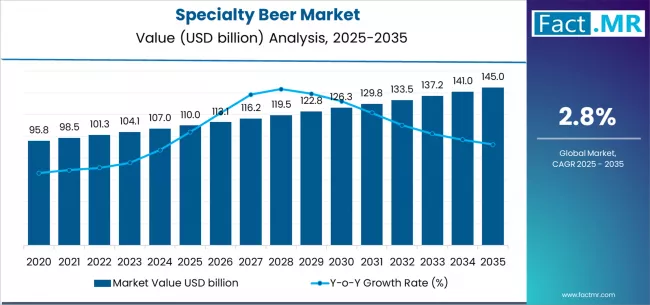
Between 2025 and 2030, the specialty beer market is projected to expand from USD 110 billion to USD 127.1 billion, resulting in a value increase of USD 17.1 billion, which represents 48.9% of the total forecast growth for the decade. This phase of development will be shaped by rising craft beer appreciation and premium brewing experiences, product innovation in unique flavor profiles and brewing techniques, as well as expanding distribution through specialized retail channels and craft brewery taprooms. Companies are establishing competitive positions through investment in advanced brewing technologies, premium ingredient sourcing capabilities, and strategic market expansion across craft beer enthusiasts and premium beverage applications.
From 2030 to 2035, the market is forecast to grow from USD 127.1 billion to USD 145 billion, adding another USD 17.9 billion, which constitutes 51.1% of the overall ten-year expansion. This period is expected to be characterized by the expansion of specialized craft brewing operations, including small-batch productions and limited-edition seasonal varieties tailored for specific consumer preferences, strategic partnerships between craft breweries and distribution networks, and an enhanced focus on sustainable brewing practices and local ingredient sourcing. The growing emphasis on authentic brewing experiences and artisanal quality will drive demand for innovative specialty beer solutions across diverse consumption applications.
Specialty Beer Market Key Takeaways
| Metric | Value |
|---|---|
| Market Value (2025) | USD 110 billion |
| Market Forecast Value (2035) | USD 145 billion |
| Forecast CAGR (2025-2035) | 2.8% |
Why is the Specialty Beer Market Growing?
The specialty beer market grows by enabling consumers to experience unique flavor profiles and artisanal brewing quality while accessing premium craft beverages without compromising on taste complexity or brewing authenticity requirements. Beer enthusiasts and craft beverage consumers face mounting pressure to discover distinctive brewing experiences and support local artisanal producers, with specialty beers typically providing 70-90% more flavor complexity compared to mass-market alternatives, making craft brewing essential for premium beverage positioning. The beverage industry's need for differentiated products and application-specific brewing styles creates demand for comprehensive craft solutions that can provide superior taste experiences, maintain consistent brewing quality, and ensure authentic artisanal production without compromising flavor innovation or brewing heritage.
Consumer trends promoting local brewing support and authentic beverage experiences drive adoption across developed and emerging markets, where craft quality has a direct impact on consumer satisfaction and brewing community development. However, production scale constraints during peak demand periods and the expertise requirements for craft brewing operations may limit expansion among smaller breweries and regions with limited brewing infrastructure for specialty production systems.
Segmental Analysis
The market is segmented by beer style, distribution channel, and packaging type. By beer style, the market is divided into craft ales/IPAs, lagers/pilsners (special), and sours/stouts/others. Based on distribution channel, the market is categorized into off-trade and on-trade channels. By packaging type, the market is divided into cans, bottles, and kegs/others. Regionally, the market is divided into Asia Pacific, Europe, North America, and other key regions.
By Beer Style, the Craft Ales/IPAs Segment Accounts for a Dominant Market Share
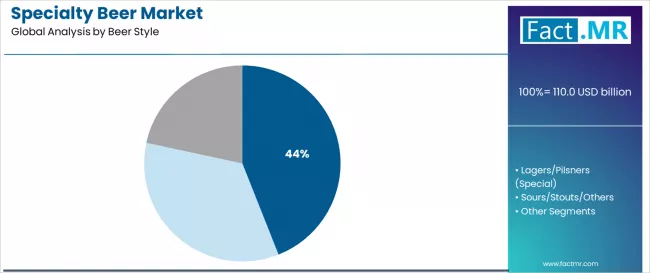
The craft ales/IPAs segment represents the dominant force in the specialty beer market, capturing approximately 44% of total market share in 2025. This established beer category encompasses India Pale Ales, American ales, and craft brewing varieties featuring complex hop profiles and innovative brewing techniques across all specialty beer segments. The craft ales/IPAs segment's market leadership stems from its superior flavor complexity and craft brewing appeal, with products capable of serving diverse taste preferences and seasonal consumption occasions while maintaining consistent brewing quality and hop character across all beer enthusiast applications.
The lagers/pilsners (special) segment maintains a substantial 31% market share, serving consumers who prefer refined brewing traditions with crisp taste profiles for classic beer experiences and sophisticated drinking occasions. These products offer premium alternatives to mass-market lagers while providing traditional brewing quality for beer consumers seeking familiar yet elevated brewing experiences. The sours/stouts/others segment accounts for approximately 25% of the market, serving adventurous consumers requiring specialized flavor experiences with unique brewing techniques and seasonal variety.
Key advantages driving the craft ales/IPAs segment include:
- Complex flavor profiles and hop-forward brewing that appeals to craft beer enthusiasts
- Innovative brewing techniques enabling seasonal variety and limited-edition offerings
- Versatile consumption occasions from casual drinking to beer pairing experiences
- Craft brewery differentiation features, providing unique brand positioning and brewing authenticity
By Distribution Channel, the Off-Trade Segment Accounts for the Largest Market Share
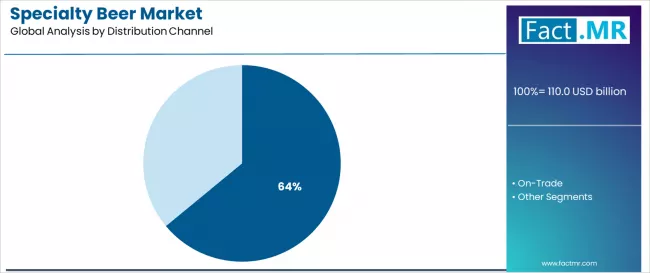
Off-trade channels dominate the specialty beer market with approximately 64% market share in 2025, reflecting the critical role of retail stores, supermarkets, and specialty beer shops in supporting global craft beer distribution and consumer accessibility worldwide. The off-trade segment's market leadership is reinforced by convenient purchasing options, competitive pricing strategies, and extensive product variety that meets diverse consumer preferences across home consumption markets.
The on-trade segment represents the distribution category, capturing 36% market share through bars, restaurants, and brewery taprooms serving social consumption experiences and craft beer discovery needs. This segment benefits from experiential consumption environments and expert beer service that provide authentic craft brewery experiences, particularly important for beer education and brand discovery among craft enthusiasts.
Key market dynamics supporting distribution channel growth include:
- Off-trade expansion driven by home consumption trends and convenience shopping preferences
- On-trade resilience through experiential dining and craft brewery tourism experiences
- Integration of hybrid distribution strategies combining retail availability with taproom experiences
- Growing emphasis on craft beer education and authentic brewing experiences across all channels
What are the Drivers, Restraints, and Key Trends of the Specialty Beer Market?
The market is driven by three concrete demand factors tied to consumer taste outcomes. First, increasing craft beer appreciation and flavor exploration create rising demand for unique brewing experiences, with specialty beer consumption expanding by 4-7% annually in major developing markets worldwide, requiring comprehensive craft brewing infrastructure. Second, local brewing support and artisanal quality trends drive increased adoption of specialty beers, with many consumers implementing craft-first purchasing goals that prioritize local brewery support by 2030. Third, technological advancements in brewing techniques and ingredient sourcing enable more innovative and sustainable products that reduce environmental impact while improving flavor complexity and brewing consistency.
Market restraints include regulatory complexity and taxation policies that can deter craft brewery expansion from specialty beer production, particularly in markets where alcohol regulations remain restrictive. Production capacity limitations and ingredient cost volatility pose another significant challenge, as specialty brewing requires premium ingredients and specialized equipment, potentially causing increased production costs and pricing pressures. Regional market access and distribution challenges create additional operational difficulties for craft breweries, demanding ongoing investment in distribution networks and market development strategies.
Key trends indicate accelerated adoption in Asia-Pacific markets, particularly China and India, where growing beer culture and premium beverage consumption drive comprehensive craft beer adoption growth. Technology integration trends toward sustainable brewing practices with eco-friendly production, smart brewing systems with quality monitoring, and innovative ingredient combinations enable enhanced brewing approaches that reduce environmental impact and improve product consistency. However, the market thesis could face disruption if alternative alcoholic beverages or significant changes in alcohol consumption patterns reduce reliance on traditional craft beer categories.
Analysis of the Specialty Beer Market by Key Country
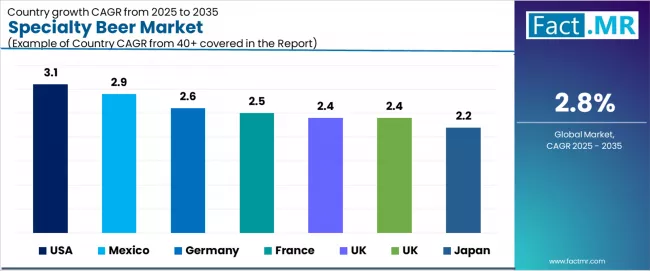
| Country | CAGR (2025-2035) |
|---|---|
| USA | 3.1% |
| Mexico | 2.9% |
| Germany | 2.6% |
| France | 2.5% |
| UK | 2.4% |
| South Korea | 2.4% |
| Japan | 2.2% |
The specialty beer market is gaining momentum worldwide, with the USA taking the lead thanks to strong craft brewery culture and premium beer consumption preferences. Close behind, Mexico benefits from expanding beer culture and growing craft brewery establishment, positioning itself as a strategic growth hub in the Latin American region. Germany shows steady advancement, where traditional brewing heritage strengthens its role in the European specialty beer supply chain. France and UK are focusing on craft innovation and brewing diversity, signaling ambition to capitalize on the growing opportunities in premium beer markets. Meanwhile, South Korea stands out for its emerging craft culture and innovative brewing approaches, and Japan continues to record consistent progress in quality-focused brewing modernization. Together, USA and Mexico anchor the global expansion story, while the rest build stability and diversity into the market's growth path.
The report covers an in-depth analysis of 40+ countries, the top-performing countries are highlighted below.
USA Leads Global Market Expansion
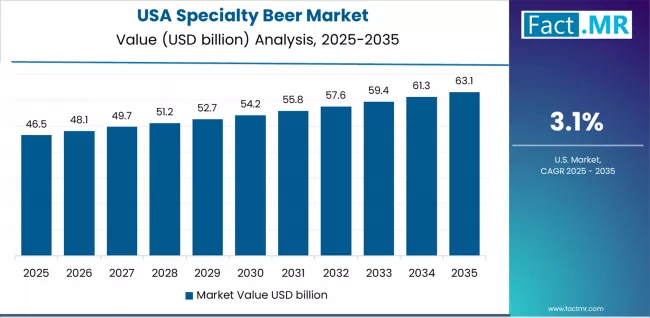
The USA demonstrates the strongest growth potential in the Specialty Beer Market with a CAGR of 3.1% through 2035. The country's leadership position stems from established craft brewery culture, premium beer appreciation, and extensive brewing distribution networks driving the adoption of artisanal beer solutions. Growth is concentrated in major brewing regions, including California, Colorado, Oregon, and Vermont, where craft beer enthusiasts and brewing communities are implementing comprehensive specialty beer strategies for enhanced taste experiences and local brewery support. Distribution channels through craft beer retailers and brewery taprooms expand coverage across beer enthusiast segments and premium beverage initiatives. The country's brewing heritage and craft culture provide market support for specialty beer adoption, including innovative and seasonal categories.
Key market factors:
- Craft brewery expansion concentrated in brewing regions with comprehensive artisanal development programs
- Distribution infrastructure through specialty retailers and taprooms supporting widespread craft product availability
- Comprehensive beer education ecosystem, including craft beer associations promoting brewing appreciation practices
- Technology integration featuring innovative brewing equipment, sustainable production, and quality monitoring technologies
Mexico Emerges as Regional Leader
In Mexico City, Guadalajara, Monterrey, and Tijuana, the adoption of comprehensive specialty beer solutions is accelerating across growing middle-class consumers and beer culture enthusiasts, driven by economic growth and increasing brewing appreciation programs. The market demonstrates strong growth momentum with a CAGR of 2.9% through 2035, linked to comprehensive cultural development and increasing focus on craft brewing accessibility solutions. Mexican consumers are implementing modern beer consumption strategies and quality brewery products to enhance social experiences while meeting growing craft demands in expanding hospitality and entertainment sectors. The country's cultural beer appreciation and economic growth create sustained demand for specialty beer solutions, while increasing emphasis on local brewing drives adoption of craft brewery and artisanal production systems.
- Leading brewing expansion cities, including Mexico City, Guadalajara, Puebla, and León, are driving craft beer adoption
- Cultural development models enabling 30% faster craft brewery deployment timelines
- Trade partnership agreements are accelerating development with international brewing technology providers
- Cultural support through beer festival initiatives and brewing education programs
Germany Maintains Brewing Heritage
The specialty beer sector in Germany demonstrates sophisticated implementation of traditional brewing solutions, with documented heritage breweries showing consistent quality leadership through centuries-old brewing traditions and premium positioning strategies. The country's beer culture in major cities, including Munich, Berlin, Hamburg, and Cologne, showcases integration of specialty brewing with existing beer heritage, leveraging expertise in traditional brewing techniques and quality standards. German consumers emphasize brewing purity and quality standards, creating demand for specialty beer solutions that support traditional beer culture and authentic brewing requirements. The market maintains steady growth through focus on heritage positioning and brewing excellence, with a CAGR of 2.6% through 2035.
Key development areas:
- Traditional brewery facilities and heritage brewing centers leading quality positioning with comprehensive authenticity programs
- Beer culture channels providing specialized solutions with traditional and premium applications
- Technology partnerships between German heritage breweries and modern brewing innovations are expanding market reach
- Integration of traditional brewing purity laws with modern specialty brewing techniques and quality innovations
France Shows Brewing Innovation
The expansion of the specialty beer market in France is driven by craft brewing growth, including artisanal breweries in Paris and other major cities, and comprehensive brewing culture development across multiple regions. The country demonstrates promising growth potential with a CAGR of 2.5% through 2035, supported by culinary culture programs and premium beverage positioning. French consumers face beer culture development challenges related to wine culture dominance and brewing tradition establishment, requiring innovative brewery approaches and support from craft brewing providers. However, growing craft awareness and culinary appreciation create compelling business cases for specialty beer adoption, particularly in urban areas where culinary diversity has a direct impact on beverage culture and gastronomic experiences.
Market characteristics:
- Craft brewing segment showing fastest growth with specialized artisanal product development
- Culinary integration trends focused on beer and food pairing innovations and gastronomic applications
- Innovation projections indicate the need for French-style brewing techniques and culinary-focused beer varieties
- Growing emphasis on artisanal quality and gastronomic integration in urban culinary markets
United Kingdom Demonstrates Craft Renaissance
The UK market leads in craft brewing innovation based on integration with traditional pub culture and modern brewing systems for enhanced beer experiences. The country shows moderate growth potential with a CAGR of 2.4% through 2035, driven by the modernization of pub infrastructure and the expansion of craft brewery networks in major cities, including London, Manchester, Birmingham, and Edinburgh. British consumers are adopting innovative brewing systems for cultural preservation and taste differentiation, particularly in regions with strong pub culture and craft brewing demanding comprehensive tradition upgrades. Technology deployment channels through established pub networks and craft breweries expand coverage across beer culture enthusiasts and brewing heritage initiatives.
Leading market segments:
- Craft brewing projects in major cities are implementing comprehensive tradition-modern integration upgrades
- Pub culture partnerships with craft breweries, achieving significant taste variety improvement rates
- Strategic collaborations between UK brewing companies and international craft brewing specialists are expanding cultural capabilities
- Focus on heritage-modern integration and craft brewing requirements
South Korea Emphasizes Innovation Adoption
In Seoul, Busan, Incheon, and Daegu, brewing facilities are implementing comprehensive specialty beer solutions to establish modern beer culture and improve taste accessibility, with documented case studies showing enhanced beer appreciation through craft brewing integration. The market shows moderate growth potential with a CAGR of 2.4% through 2035, linked to the establishment of beer culture, craft brewery networks, and emerging brewing education projects in major cities. Korean consumers are adopting innovative beer varieties and modern brewing platforms to enhance social experiences while developing beer appreciation standards demanded by the growing hospitality and entertainment industries. The country's developing beer culture creates sustained demand for education and modernization solutions that integrate with existing social culture systems.
Market development factors:
- Craft brewery facilities and beer culture networks leading brewing modernization initiatives across major Korean cities
- Cultural development programs providing government support for brewing education and beer culture infrastructure upgrades
- Strategic partnerships between Korean companies and international craft brewing providers are expanding brewing capabilities
- Emphasis on social culture integration and modern brewing adoption across entertainment applications
Japan Emphasizes Quality Brewing
The specialty beer market in Japan demonstrates sophisticated implementation focused on brewing precision and quality excellence, with documented integration of craft brewing systems, achieving superior quality standards across consumer and hospitality applications. The country maintains steady growth momentum with a CAGR of 2.2% through 2035, driven by consumer emphasis on quality standards and brewing refinement methodologies that align with traditional quality principles applied to modern brewing practices. Major metropolitan areas, including Tokyo, Osaka, Kyoto, and Sapporo, showcase advanced deployment of specialty brewing solutions where quality systems integrate seamlessly with existing hospitality infrastructure and comprehensive quality management programs.
Key market characteristics:
- Specialty brewing facilities and quality control systems are driving advanced precision requirements with emphasis on brewing excellence
- Hospitality integration partnerships enabling superior quality standards with comprehensive taste optimization programs
- Technology collaboration between Japanese quality leaders and international craft brewing providers is expanding market capabilities
- Emphasis on precision brewing requirements and traditional quality integration methodologies
Europe Market Split by Country
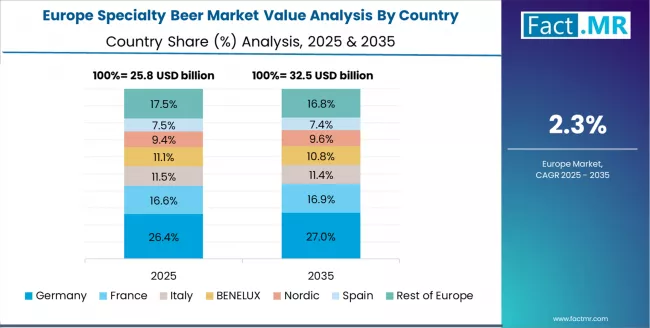
The specialty beer market in Europe is projected to grow from USD 27.5 billion in 2025 to USD 35.6 billion by 2035, registering a CAGR of 2.6% over the forecast period. Germany is expected to maintain its leadership position with a 31.4% market share in 2025, increasing slightly to 31.9% by 2035, supported by its strong brewing heritage, traditional beer culture, and comprehensive brewery distribution networks serving major European markets.
The United Kingdom follows with a 26.7% share in 2025, projected to reach 27.1% by 2035, driven by comprehensive craft brewing programs in London, Manchester, and other brewing cities implementing advanced specialty beer systems. France holds a 18.9% share in 2025, expected to maintain 18.6% by 2035 through the ongoing development of artisanal brewing infrastructure and culinary beer integration networks. Italy commands a 13.2% share, while Spain accounts for 6.1% in 2025. The Rest of Europe region is anticipated to gain momentum, expanding its collective share from 3.7% to 4.1% by 2035, attributed to increasing craft beer adoption in Nordic countries and emerging Eastern European brewing markets implementing specialty beer programs.
Traditional Brewing Dominates Heritage Demand in Japan
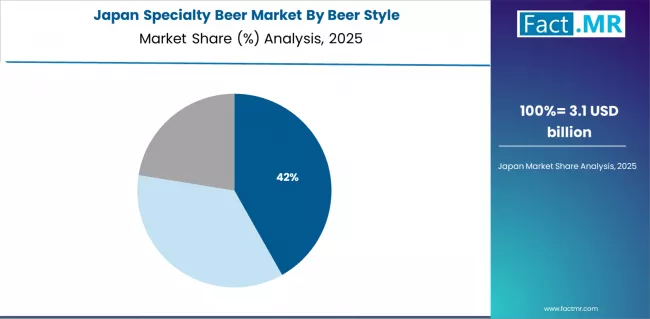
The specialty beer market in Japan demonstrates a mature and quality-focused landscape, characterized by sophisticated integration of precision brewing with existing hospitality culture infrastructure across convenience stores, restaurants, and premium beverage networks. Japan's emphasis on quality standards and brewing precision drives demand for high-quality beer solutions that support traditional hospitality principles and modern taste consciousness initiatives in consumer beverage experiences. The market benefits from strong partnerships between international brewing providers like Asahi, Sapporo, and domestic quality leaders, creating comprehensive service ecosystems that prioritize product excellence and consumer taste programs. Urban centers in Tokyo, Osaka, Sapporo, and other major metropolitan areas showcase advanced quality implementations where brewing systems achieve superior precision standards through integrated quality monitoring programs.
Innovation Integration Leads Brewing Services in South Korea
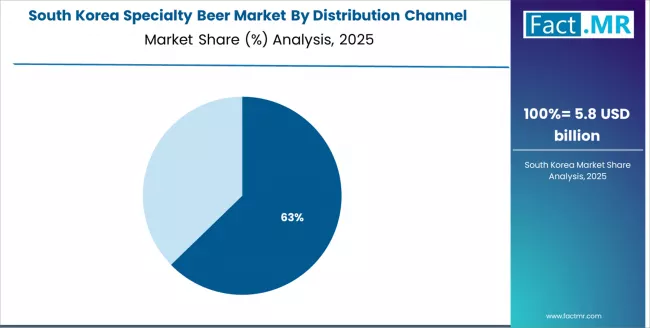
The South Korean specialty beer market is characterized by strong innovation provider presence, with companies like AB InBev, Heineken, and local craft brewers maintaining positions through comprehensive cultural integration and innovative product capabilities for K-culture and entertainment-focused applications. The market is demonstrating a growing emphasis on craft brewing products and cultural trend integration, as Korean consumers increasingly demand specialty beers that integrate with domestic social culture and advanced entertainment systems deployed across the Seoul Metropolitan Area and other major entertainment cities. Local brewing companies and regional craft brewers are gaining market share through strategic partnerships with global providers, offering specialized products including cultural-themed beers and certification services for brewing specialists. The competitive landscape shows increasing collaboration between multinational brewing companies and Korean cultural specialists, creating hybrid product models that combine international brewing expertise with local cultural knowledge and consumer experience management.
Competitive Landscape of the Specialty Beer Market
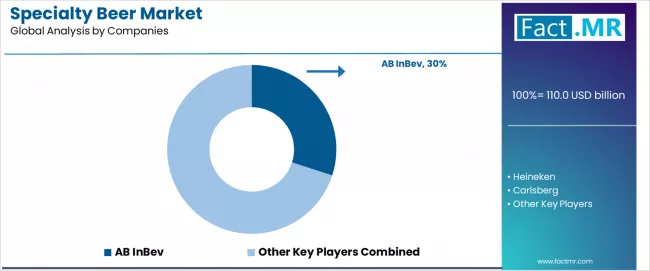
The specialty beer market features approximately 40-60 meaningful players with moderate concentration, where the top three companies control roughly 25-32% of global market share through established brewing portfolios and extensive distribution networks. Competition centers on brewing innovation, brand authenticity, and quality consistency rather than price competition alone.
Market leaders include AB InBev, Heineken, and Carlsberg, which maintain competitive advantages through comprehensive craft portfolios, global distribution networks, and deep expertise in the brewing and beverage sectors, creating high brand recognition for customers. These companies leverage established brewery relationships and ongoing brewing investments to defend market positions while expanding into craft and specialty brewing categories.
Challengers encompass Constellation and Asahi, which compete through specialized brewing innovations and strong regional presence in key beer markets. Craft brewing specialists, including Molson Coors, Sierra Nevada, and Boston Beer, focus on specific artisanal segments or brewing excellence, offering differentiated capabilities in craft positioning, local brewing, and consumer-focused solutions.
Independent craft breweries and emerging specialty brands create competitive pressure through authentic brewing approaches and innovative flavor developments, particularly in high-growth markets including North America and emerging economies, where local presence provides advantages in cultural understanding and taste preferences. Market dynamics favor companies that combine brewing authenticity with comprehensive distribution capabilities that address the complete consumer beer experience lifecycle from brewing innovation through ongoing taste development and brand loyalty programs.
Key Players in the Specialty Beer Market
- AB InBev
- Heineken
- Carlsberg
- Constellation
- Asahi
- Molson Coors
- Sierra Nevada
- Boston Beer
- BrewDog
- Duvel
Scope of the Report
| Item | Value |
|---|---|
| Quantitative Units | USD 110 billion |
| Beer Style | Craft Ales/IPAs, Lagers/Pilsners (Special), Sours/Stouts/Others |
| Distribution Channel | Off-Trade, On-Trade |
| Packaging Type | Cans, Bottles, Kegs/Others |
| Regions Covered | Asia Pacific, Europe, North America, Latin America, Middle East & Africa |
| Country Covered | USA, UK, Germany, France, Japan, South Korea, Mexico, and 40+ countries |
| Key Companies Profiled | AB InBev, Heineken, Carlsberg, Constellation, Asahi, Molson Coors, Sierra Nevada, Boston Beer, BrewDog, Duvel |
| Additional Attributes | Dollar sales by beer style and packaging type segments, regional brewing trends across Asia Pacific, Europe, and North America, competitive landscape with brewing companies and craft brewery networks, consumer taste preferences and craft beer appreciation factors, integration with brewing heritage traditions and innovation applications, advancements in brewing technology and quality management systems, and development of specialized products with artisanal brewing and flavor complexity capabilities. |
Specialty Beer Market by Segments
-
Beer Style :
- Craft Ales/IPAs
- Lagers/Pilsners (Special)
- Sours/Stouts/Others
-
Distribution Channel :
- Off-Trade
- On-Trade
-
Packaging Type :
- Cans
- Bottles
- Kegs/Others
-
Region :
- Asia Pacific
- China
- Japan
- South Korea
- India
- Australia & New Zealand
- ASEAN
- Rest of Asia Pacific
- Europe
- Germany
- United Kingdom
- France
- Italy
- Spain
- Nordic
- BENELUX
- Rest of Europe
- North America
- United States
- Canada
- Mexico
- Latin America
- Brazil
- Chile
- Rest of Latin America
- Middle East & Africa
- Kingdom of Saudi Arabia
- Other GCC Countries
- Turkey
- South Africa
- Other African Union
- Rest of Middle East & Africa
- Asia Pacific
Table of Content
- Executive Summary
- Global Market Outlook
- Demand to side Trends
- Supply to side Trends
- Technology Roadmap Analysis
- Analysis and Recommendations
- Market Overview
- Market Coverage / Taxonomy
- Market Definition / Scope / Limitations
- Market Background
- Market Dynamics
- Drivers
- Restraints
- Opportunity
- Trends
- Scenario Forecast
- Demand in Optimistic Scenario
- Demand in Likely Scenario
- Demand in Conservative Scenario
- Opportunity Map Analysis
- Product Life Cycle Analysis
- Supply Chain Analysis
- Investment Feasibility Matrix
- Value Chain Analysis
- PESTLE and Porter’s Analysis
- Regulatory Landscape
- Regional Parent Market Outlook
- Production and Consumption Statistics
- Import and Export Statistics
- Market Dynamics
- Global Market Analysis 2020 to 2024 and Forecast, 2025 to 2035
- Historical Market Size Value (USD Million) Analysis, 2020 to 2024
- Current and Future Market Size Value (USD Million) Projections, 2025 to 2035
- Y to o to Y Growth Trend Analysis
- Absolute $ Opportunity Analysis
- Global Market Pricing Analysis 2020 to 2024 and Forecast 2025 to 2035
- Global Market Analysis 2020 to 2024 and Forecast 2025 to 2035, By Beer Style
- Introduction / Key Findings
- Historical Market Size Value (USD Million) Analysis By Beer Style , 2020 to 2024
- Current and Future Market Size Value (USD Million) Analysis and Forecast By Beer Style , 2025 to 2035
- Craft Ales/IPAs
- Lagers/Pilsners (Special)
- Sours/Stouts/Others
- Y to o to Y Growth Trend Analysis By Beer Style , 2020 to 2024
- Absolute $ Opportunity Analysis By Beer Style , 2025 to 2035
- Global Market Analysis 2020 to 2024 and Forecast 2025 to 2035, By Distribution Channel
- Introduction / Key Findings
- Historical Market Size Value (USD Million) Analysis By Distribution Channel, 2020 to 2024
- Current and Future Market Size Value (USD Million) Analysis and Forecast By Distribution Channel, 2025 to 2035
- Off-Trade
- On-Trade
- Y to o to Y Growth Trend Analysis By Distribution Channel, 2020 to 2024
- Absolute $ Opportunity Analysis By Distribution Channel, 2025 to 2035
- Global Market Analysis 2020 to 2024 and Forecast 2025 to 2035, By Region
- Introduction
- Historical Market Size Value (USD Million) Analysis By Region, 2020 to 2024
- Current Market Size Value (USD Million) Analysis and Forecast By Region, 2025 to 2035
- North America
- Latin America
- Western Europe
- Eastern Europe
- East Asia
- South Asia and Pacific
- Middle East & Africa
- Market Attractiveness Analysis By Region
- North America Market Analysis 2020 to 2024 and Forecast 2025 to 2035, By Country
- Historical Market Size Value (USD Million) Trend Analysis By Market Taxonomy, 2020 to 2024
- Market Size Value (USD Million) Forecast By Market Taxonomy, 2025 to 2035
- By Country
- USA
- Canada
- Mexico
- By Beer Style
- By Distribution Channel
- By Country
- Market Attractiveness Analysis
- By Country
- By Beer Style
- By Distribution Channel
- Key Takeaways
- Latin America Market Analysis 2020 to 2024 and Forecast 2025 to 2035, By Country
- Historical Market Size Value (USD Million) Trend Analysis By Market Taxonomy, 2020 to 2024
- Market Size Value (USD Million) Forecast By Market Taxonomy, 2025 to 2035
- By Country
- Brazil
- Chile
- Rest of Latin America
- By Beer Style
- By Distribution Channel
- By Country
- Market Attractiveness Analysis
- By Country
- By Beer Style
- By Distribution Channel
- Key Takeaways
- Western Europe Market Analysis 2020 to 2024 and Forecast 2025 to 2035, By Country
- Historical Market Size Value (USD Million) Trend Analysis By Market Taxonomy, 2020 to 2024
- Market Size Value (USD Million) Forecast By Market Taxonomy, 2025 to 2035
- By Country
- Germany
- UK
- Italy
- Spain
- France
- Nordic
- BENELUX
- Rest of Western Europe
- By Beer Style
- By Distribution Channel
- By Country
- Market Attractiveness Analysis
- By Country
- By Beer Style
- By Distribution Channel
- Key Takeaways
- Eastern Europe Market Analysis 2020 to 2024 and Forecast 2025 to 2035, By Country
- Historical Market Size Value (USD Million) Trend Analysis By Market Taxonomy, 2020 to 2024
- Market Size Value (USD Million) Forecast By Market Taxonomy, 2025 to 2035
- By Country
- Russia
- Poland
- Hungary
- Balkan & Baltic
- Rest of Eastern Europe
- By Beer Style
- By Distribution Channel
- By Country
- Market Attractiveness Analysis
- By Country
- By Beer Style
- By Distribution Channel
- Key Takeaways
- East Asia Market Analysis 2020 to 2024 and Forecast 2025 to 2035, By Country
- Historical Market Size Value (USD Million) Trend Analysis By Market Taxonomy, 2020 to 2024
- Market Size Value (USD Million) Forecast By Market Taxonomy, 2025 to 2035
- By Country
- China
- Japan
- South Korea
- By Beer Style
- By Distribution Channel
- By Country
- Market Attractiveness Analysis
- By Country
- By Beer Style
- By Distribution Channel
- Key Takeaways
- South Asia and Pacific Market Analysis 2020 to 2024 and Forecast 2025 to 2035, By Country
- Historical Market Size Value (USD Million) Trend Analysis By Market Taxonomy, 2020 to 2024
- Market Size Value (USD Million) Forecast By Market Taxonomy, 2025 to 2035
- By Country
- India
- ASEAN
- Australia & New Zealand
- Rest of South Asia and Pacific
- By Beer Style
- By Distribution Channel
- By Country
- Market Attractiveness Analysis
- By Country
- By Beer Style
- By Distribution Channel
- Key Takeaways
- Middle East & Africa Market Analysis 2020 to 2024 and Forecast 2025 to 2035, By Country
- Historical Market Size Value (USD Million) Trend Analysis By Market Taxonomy, 2020 to 2024
- Market Size Value (USD Million) Forecast By Market Taxonomy, 2025 to 2035
- By Country
- Kingdom of Saudi Arabia
- Other GCC Countries
- Turkiye
- South Africa
- Other African Union
- Rest of Middle East & Africa
- By Beer Style
- By Distribution Channel
- By Country
- Market Attractiveness Analysis
- By Country
- By Beer Style
- By Distribution Channel
- Key Takeaways
- Key Countries Market Analysis
- USA
- Pricing Analysis
- Market Share Analysis, 2024
- By Beer Style
- By Distribution Channel
- Canada
- Pricing Analysis
- Market Share Analysis, 2024
- By Beer Style
- By Distribution Channel
- Mexico
- Pricing Analysis
- Market Share Analysis, 2024
- By Beer Style
- By Distribution Channel
- Brazil
- Pricing Analysis
- Market Share Analysis, 2024
- By Beer Style
- By Distribution Channel
- Chile
- Pricing Analysis
- Market Share Analysis, 2024
- By Beer Style
- By Distribution Channel
- Germany
- Pricing Analysis
- Market Share Analysis, 2024
- By Beer Style
- By Distribution Channel
- UK
- Pricing Analysis
- Market Share Analysis, 2024
- By Beer Style
- By Distribution Channel
- Italy
- Pricing Analysis
- Market Share Analysis, 2024
- By Beer Style
- By Distribution Channel
- Spain
- Pricing Analysis
- Market Share Analysis, 2024
- By Beer Style
- By Distribution Channel
- France
- Pricing Analysis
- Market Share Analysis, 2024
- By Beer Style
- By Distribution Channel
- India
- Pricing Analysis
- Market Share Analysis, 2024
- By Beer Style
- By Distribution Channel
- ASEAN
- Pricing Analysis
- Market Share Analysis, 2024
- By Beer Style
- By Distribution Channel
- Australia & New Zealand
- Pricing Analysis
- Market Share Analysis, 2024
- By Beer Style
- By Distribution Channel
- China
- Pricing Analysis
- Market Share Analysis, 2024
- By Beer Style
- By Distribution Channel
- Japan
- Pricing Analysis
- Market Share Analysis, 2024
- By Beer Style
- By Distribution Channel
- South Korea
- Pricing Analysis
- Market Share Analysis, 2024
- By Beer Style
- By Distribution Channel
- Russia
- Pricing Analysis
- Market Share Analysis, 2024
- By Beer Style
- By Distribution Channel
- Poland
- Pricing Analysis
- Market Share Analysis, 2024
- By Beer Style
- By Distribution Channel
- Hungary
- Pricing Analysis
- Market Share Analysis, 2024
- By Beer Style
- By Distribution Channel
- Kingdom of Saudi Arabia
- Pricing Analysis
- Market Share Analysis, 2024
- By Beer Style
- By Distribution Channel
- Turkiye
- Pricing Analysis
- Market Share Analysis, 2024
- By Beer Style
- By Distribution Channel
- South Africa
- Pricing Analysis
- Market Share Analysis, 2024
- By Beer Style
- By Distribution Channel
- USA
- Market Structure Analysis
- Competition Dashboard
- Competition Benchmarking
- Market Share Analysis of Top Players
- By Regional
- By Beer Style
- By Distribution Channel
- Competition Analysis
- Competition Deep Dive
- AB InBev
- Overview
- Product Portfolio
- Profitability by Market Segments (Product/Age /Sales Channel/Region)
- Sales Footprint
- Strategy Overview
- Marketing Strategy
- Product Strategy
- Channel Strategy
- Heineken
- Carlsberg
- Constellation
- Asahi
- Molson Coors
- Sierra Nevada
- Boston Beer
- BrewDog
- Duvel
- AB InBev
- Competition Deep Dive
- Assumptions & Acronyms Used
- Research Methodology
List Of Table
- Table 1: Global Market Value (USD Million) Forecast by Region, 2020 to 2035
- Table 2: Global Market Value (USD Million) Forecast by Beer Style , 2020 to 2035
- Table 3: Global Market Value (USD Million) Forecast by Distribution Channel, 2020 to 2035
- Table 4: North America Market Value (USD Million) Forecast by Country, 2020 to 2035
- Table 5: North America Market Value (USD Million) Forecast by Beer Style , 2020 to 2035
- Table 6: North America Market Value (USD Million) Forecast by Distribution Channel, 2020 to 2035
- Table 7: Latin America Market Value (USD Million) Forecast by Country, 2020 to 2035
- Table 8: Latin America Market Value (USD Million) Forecast by Beer Style , 2020 to 2035
- Table 9: Latin America Market Value (USD Million) Forecast by Distribution Channel, 2020 to 2035
- Table 10: Western Europe Market Value (USD Million) Forecast by Country, 2020 to 2035
- Table 11: Western Europe Market Value (USD Million) Forecast by Beer Style , 2020 to 2035
- Table 12: Western Europe Market Value (USD Million) Forecast by Distribution Channel, 2020 to 2035
- Table 13: Eastern Europe Market Value (USD Million) Forecast by Country, 2020 to 2035
- Table 14: Eastern Europe Market Value (USD Million) Forecast by Beer Style , 2020 to 2035
- Table 15: Eastern Europe Market Value (USD Million) Forecast by Distribution Channel, 2020 to 2035
- Table 16: East Asia Market Value (USD Million) Forecast by Country, 2020 to 2035
- Table 17: East Asia Market Value (USD Million) Forecast by Beer Style , 2020 to 2035
- Table 18: East Asia Market Value (USD Million) Forecast by Distribution Channel, 2020 to 2035
- Table 19: South Asia and Pacific Market Value (USD Million) Forecast by Country, 2020 to 2035
- Table 20: South Asia and Pacific Market Value (USD Million) Forecast by Beer Style , 2020 to 2035
- Table 21: South Asia and Pacific Market Value (USD Million) Forecast by Distribution Channel, 2020 to 2035
- Table 22: Middle East & Africa Market Value (USD Million) Forecast by Country, 2020 to 2035
- Table 23: Middle East & Africa Market Value (USD Million) Forecast by Beer Style , 2020 to 2035
- Table 24: Middle East & Africa Market Value (USD Million) Forecast by Distribution Channel, 2020 to 2035
List Of Figures
- Figure 1: Global Market Pricing Analysis
- Figure 2: Global Market Value (USD Million) Forecast 2020-2035
- Figure 3: Global Market Value Share and BPS Analysis by Beer Style , 2025 and 2035
- Figure 4: Global Market Y to o to Y Growth Comparison by Beer Style , 2025-2035
- Figure 5: Global Market Attractiveness Analysis by Beer Style
- Figure 6: Global Market Value Share and BPS Analysis by Distribution Channel, 2025 and 2035
- Figure 7: Global Market Y to o to Y Growth Comparison by Distribution Channel, 2025-2035
- Figure 8: Global Market Attractiveness Analysis by Distribution Channel
- Figure 9: Global Market Value (USD Million) Share and BPS Analysis by Region, 2025 and 2035
- Figure 10: Global Market Y to o to Y Growth Comparison by Region, 2025-2035
- Figure 11: Global Market Attractiveness Analysis by Region
- Figure 12: North America Market Incremental Dollar Opportunity, 2025-2035
- Figure 13: Latin America Market Incremental Dollar Opportunity, 2025-2035
- Figure 14: Western Europe Market Incremental Dollar Opportunity, 2025-2035
- Figure 15: Eastern Europe Market Incremental Dollar Opportunity, 2025-2035
- Figure 16: East Asia Market Incremental Dollar Opportunity, 2025-2035
- Figure 17: South Asia and Pacific Market Incremental Dollar Opportunity, 2025-2035
- Figure 18: Middle East & Africa Market Incremental Dollar Opportunity, 2025-2035
- Figure 19: North America Market Value Share and BPS Analysis by Country, 2025 and 2035
- Figure 20: North America Market Value Share and BPS Analysis by Beer Style , 2025 and 2035
- Figure 21: North America Market Y to o to Y Growth Comparison by Beer Style , 2025-2035
- Figure 22: North America Market Attractiveness Analysis by Beer Style
- Figure 23: North America Market Value Share and BPS Analysis by Distribution Channel, 2025 and 2035
- Figure 24: North America Market Y to o to Y Growth Comparison by Distribution Channel, 2025-2035
- Figure 25: North America Market Attractiveness Analysis by Distribution Channel
- Figure 26: Latin America Market Value Share and BPS Analysis by Country, 2025 and 2035
- Figure 27: Latin America Market Value Share and BPS Analysis by Beer Style , 2025 and 2035
- Figure 28: Latin America Market Y to o to Y Growth Comparison by Beer Style , 2025-2035
- Figure 29: Latin America Market Attractiveness Analysis by Beer Style
- Figure 30: Latin America Market Value Share and BPS Analysis by Distribution Channel, 2025 and 2035
- Figure 31: Latin America Market Y to o to Y Growth Comparison by Distribution Channel, 2025-2035
- Figure 32: Latin America Market Attractiveness Analysis by Distribution Channel
- Figure 33: Western Europe Market Value Share and BPS Analysis by Country, 2025 and 2035
- Figure 34: Western Europe Market Value Share and BPS Analysis by Beer Style , 2025 and 2035
- Figure 35: Western Europe Market Y to o to Y Growth Comparison by Beer Style , 2025-2035
- Figure 36: Western Europe Market Attractiveness Analysis by Beer Style
- Figure 37: Western Europe Market Value Share and BPS Analysis by Distribution Channel, 2025 and 2035
- Figure 38: Western Europe Market Y to o to Y Growth Comparison by Distribution Channel, 2025-2035
- Figure 39: Western Europe Market Attractiveness Analysis by Distribution Channel
- Figure 40: Eastern Europe Market Value Share and BPS Analysis by Country, 2025 and 2035
- Figure 41: Eastern Europe Market Value Share and BPS Analysis by Beer Style , 2025 and 2035
- Figure 42: Eastern Europe Market Y to o to Y Growth Comparison by Beer Style , 2025-2035
- Figure 43: Eastern Europe Market Attractiveness Analysis by Beer Style
- Figure 44: Eastern Europe Market Value Share and BPS Analysis by Distribution Channel, 2025 and 2035
- Figure 45: Eastern Europe Market Y to o to Y Growth Comparison by Distribution Channel, 2025-2035
- Figure 46: Eastern Europe Market Attractiveness Analysis by Distribution Channel
- Figure 47: East Asia Market Value Share and BPS Analysis by Country, 2025 and 2035
- Figure 48: East Asia Market Value Share and BPS Analysis by Beer Style , 2025 and 2035
- Figure 49: East Asia Market Y to o to Y Growth Comparison by Beer Style , 2025-2035
- Figure 50: East Asia Market Attractiveness Analysis by Beer Style
- Figure 51: East Asia Market Value Share and BPS Analysis by Distribution Channel, 2025 and 2035
- Figure 52: East Asia Market Y to o to Y Growth Comparison by Distribution Channel, 2025-2035
- Figure 53: East Asia Market Attractiveness Analysis by Distribution Channel
- Figure 54: South Asia and Pacific Market Value Share and BPS Analysis by Country, 2025 and 2035
- Figure 55: South Asia and Pacific Market Value Share and BPS Analysis by Beer Style , 2025 and 2035
- Figure 56: South Asia and Pacific Market Y to o to Y Growth Comparison by Beer Style , 2025-2035
- Figure 57: South Asia and Pacific Market Attractiveness Analysis by Beer Style
- Figure 58: South Asia and Pacific Market Value Share and BPS Analysis by Distribution Channel, 2025 and 2035
- Figure 59: South Asia and Pacific Market Y to o to Y Growth Comparison by Distribution Channel, 2025-2035
- Figure 60: South Asia and Pacific Market Attractiveness Analysis by Distribution Channel
- Figure 61: Middle East & Africa Market Value Share and BPS Analysis by Country, 2025 and 2035
- Figure 62: Middle East & Africa Market Value Share and BPS Analysis by Beer Style , 2025 and 2035
- Figure 63: Middle East & Africa Market Y to o to Y Growth Comparison by Beer Style , 2025-2035
- Figure 64: Middle East & Africa Market Attractiveness Analysis by Beer Style
- Figure 65: Middle East & Africa Market Value Share and BPS Analysis by Distribution Channel, 2025 and 2035
- Figure 66: Middle East & Africa Market Y to o to Y Growth Comparison by Distribution Channel, 2025-2035
- Figure 67: Middle East & Africa Market Attractiveness Analysis by Distribution Channel
- Figure 68: Global Market - Tier Structure Analysis
- Figure 69: Global Market - Company Share Analysis
- FAQs -
How big is the specialty beer market in 2025?
The global specialty beer market is estimated to be valued at USD 110.0 billion in 2025.
What will be the size of specialty beer market in 2035?
The market size for the specialty beer market is projected to reach USD 145.0 billion by 2035.
How much will be the specialty beer market growth between 2025 and 2035?
The specialty beer market is expected to grow at a 2.8% CAGR between 2025 and 2035.
What are the key product types in the specialty beer market?
The key product types in specialty beer market are craft ales/ipas, lagers/pilsners (special) and sours/stouts/others.
Which distribution channel segment to contribute significant share in the specialty beer market in 2025?
In terms of distribution channel, off-trade segment to command 64.0% share in the specialty beer market in 2025.